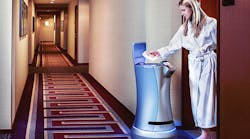RoboBusiness 2015, scheduled for Sept. 23–24 in San Jose, Calif., is fast approaching. The last time I attended this event, it was via a telepresence robot (see “Attending Robobusiness Using A Telepresence Robot” on Electronic Design).
For this year’s installment, Rob High, IBM fellow and CTO at Watson IBM (Fig. 1), will be delivering the keynote. He will be talking about some the applications made possible cognitive computing added to hardware like Watson. This incudes how Human-Machine Interaction (HMI) will develop in the future and what corporations can expect from the next generation of “cognitive robots” to support their business.
Ray Kurzweil, director of engineering at Google, will be giving the keynote on Thursday. He will be sharing his vision for how the corporate landscape will be transformed as new businesses and business models are created thanks to robotics technologies.
Of course, there will be all sorts of robotics on display and rolling around the aisles. Rethink Robotics’ Baxter (Fig. 2) will be on display at the show running the Intera Robot Positioning System. Baxter uses multiple sensors, included embedded vision systems, that allow it to work in close quarters with people and other robots (see “Vision Systems Give Robots a Glimpse at their Work” on Electronic Design). Its compliant motion control system allows Baxter to work in semi-structured environments. The new Intera 3.3 allows the robot to operate at three times the speed and twice the precision of the original.
Fetch Robotics is targeting the logistics industry with its Freight mobile base and the Fetch advanced mobile manipulator (Fig. 3). Fetch and Freight robots can collaborate to fulfill orders in a warehouse. Each robot is capable of independent, autonomous behavior. They use a charging dock for continuous autonomous operations. The robots are designed to work alongside human workers, performing repetitive tasks like delivery, pick and pack, and more. It is possible to use a Fetch and Freight robot to pick items and place them in carriers riding atop a Freight robot.
Fellow Robots (Fig. 4) uses advance voice recognition to interact with retail store customers. A customer, for example, could say “I am looking for a doorknob.” will then provide product information and guide the customer to its location in the store. It uses advanced sensors, wireless networking, and voice recognition to perform these functions, along with a pair of large screens for providing information and interacting with customers. There is a 3D scanner on the head and laser sensors in the base.
5. Saviokeâs Relay robot will be found in hotels where they interact with customers. (Image courtesy of Savioke).
Finally, Savioke’s Relay robot (Fig. 5) will be found in hotels. It can deliver snacks and amenities in its flip top carrier. It allows employees to concentrate running the hotel and interacting with customers while Relay handles deliveries to hotel rooms. It is already in use at some major hotels—although you will need to check out the silhouette, as most hotels like to give it their own name. Relay uses Intel’s RealSense 3D camera (see “Software Leverages 3D Imaging Hardware” on Electronic Design) and was highlighted at this year’s Intel Developer Forum. Relay runs the Robot Operating System (ROS), an open source (see “These Robots Are No Danger, Will Robinson” on Electronic Design).






